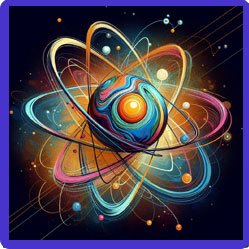
Atoms and Radiation
Atoms are the building blocks of matter, consisting of a nucleus surrounded by electrons. Radiation is the emission and transmission of energy in the form of particles or waves. Understanding atoms and radiation helps us comprehend radioactivity, nuclear reactions, and the behaviour of matter at the atomic level.
The history behind the Model of the Atom
Democritus (5th century BC) was an ancient Greek philosopher who proposed the concept of the atom. He believed that all matter is made up of tiny, indivisible particles called "atomos," which means "uncuttable" in Greek.
John Dalton (1804) was an English chemist who developed the first modern atomic theory. He proposed that elements are made up of tiny, indivisible particles called atoms, which are identical in size, mass, and properties for each element. Dalton's theory also introduced the concept that atoms combine in simple whole-number ratios to form compounds.
J.J. Thomson (1897) was a British physicist who discovered the electron. Using cathode ray tube experiments, he found that atoms contain negatively charged particles, later named electrons. Thomson proposed the "plum pudding" model of the atom, where electrons are embedded in a positively charged sphere, similar to raisins in a pudding.
Ernest Rutherford (1909) was a New Zealand-born physicist who conducted the famous gold foil experiment. He discovered the nucleus of the atom, which is a small, dense, positively charged region at the centre. Rutherford's model of the atom depicted a tiny, dense nucleus surrounded by orbiting electrons, similar to a miniature solar system.
Niels Bohr (1913) Bohr was a Danish physicist who developed the planetary model of the atom. He proposed that electrons orbit the nucleus in specific energy levels or shells, and each shell can hold a specific number of electrons. Bohr's model explained the spectral lines of hydrogen and provided a framework for understanding atomic structure.
What are Isotopes?
Isotopes are atoms of the same element that have the same number of protons (which determines the element) but different numbers of neutrons. Because they have the same number of protons, isotopes of an element have similar chemical properties. However, because they have different numbers of neutrons, isotopes of an element may have different atomic masses. For example, hydrogen has three isotopes: protium (1 proton), deuterium (1 proton and 1 neutron), and tritium (1 proton and 2 neutrons).
What is Nuclear Radiation?
Nuclear radiation refers to the particles or electromagnetic waves emitted from the nucleus of an unstable atom during radioactive decay. Radioactive decay occurs when the nucleus of an atom is unstable and tries to become more stable by emitting radiation.
There are three main types of nuclear radiation:
- Alpha (α) particles: Helium nuclei consisting of 2 protons and 2 neutrons.
- Beta (β) particles: High-energy electrons (β-) or positrons (β+).
- Gamma (γ) rays: Electromagnetic waves similar to X-rays but with higher energy.
Nuclear radiation can ionize atoms, meaning it can knock electrons off atoms, leading to the formation of charged particles (ions) and causing chemical changes in substances. Nuclear radiation is commonly used in medical imaging (e.g., X-rays and gamma-ray imaging), cancer treatment (e.g., radiation therapy), and energy production (e.g., nuclear power plants).
Revision Notes

The Cornell method is like a supercharged note-taking system that helps you ace your revision!
Print out our blank revision notes pages to help you revise.
How to make effective revision notes with the Cornell method.
Exam Questions & Answers

Download and print off practice our FREE worksheet with exam style questions on Cell Biology.
What is Nuclear Fission?
Nuclear fission is like breaking a big Lego block into smaller pieces. Imagine you have a big Lego block (a heavy nucleus), and you hit it with a hammer (a neutron). When you hit it, the big block breaks into two or more smaller pieces (lighter nuclei). This breaking releases a lot of energy, just like how breaking the Lego block might make a loud noise. This released energy can be used to generate electricity in nuclear power plants. So, nuclear fission is all about breaking big atomic nuclei into smaller parts to release energy.
What is Nuclear Fusion?
Nuclear fusion is like squishing two small balloons together to make a bigger one. Imagine you have two small balloons (light atomic nuclei), and you squeeze them together really hard. When you do this, the balloons combine to make one bigger balloon (a heavier nucleus). This process releases a lot of energy, like a burst of air from the balloons. Nuclear fusion is when light atomic nuclei combine to form a heavier nucleus, releasing a huge amount of energy in the process. It's the same process that powers the Sun and other stars. Scientists are trying to figure out how to harness this energy to create clean and abundant power for the future.
Revision Notes

The Cornell method is like a supercharged note-taking system that helps you ace your revision!
Print out our blank revision notes pages to help you revise.
How to make effective revision notes with the Cornell method.
Why Do I Need to Know About Atoms & Radiation?
In Everyday Life
- Understanding what radioactivity is and how it's part of the natural world—from background radiation to medical scans
- Learning why some materials are unstable, how they emit radiation, and what that means for our safety
- Recognising the types of radiation (alpha, beta, gamma), their properties, and what materials can stop them
- Grasping the concept of half-life and why knowing how quickly radiation decays is key to industries like archaeology and medicine
In Science & Physics Careers
- Designing and working with medical imaging, radiotherapy, and tools like tracers and smoke alarms that rely on radioactive materials
- Applying knowledge of radiation for industrial uses, nuclear energy, and safety protocols to protect workers and the public
- Using decay calculations (like half‑life and activity) in research, dating techniques, and fields like nuclear physics or environmental science
- Learning how to manage risks and improve radiation shielding—essential in labs, hospitals, and engineering contexts


